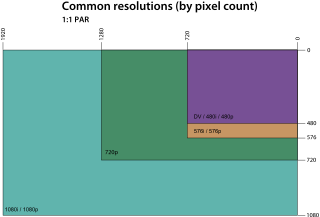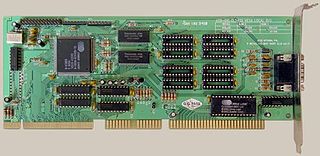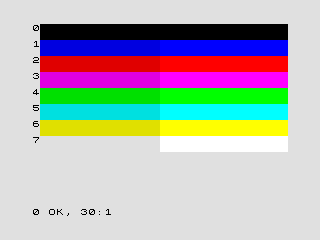 W
WExtra Half-Brite (EHB) mode is a planar display mode of the Commodore Amiga computer. It uses six bitplanes. The first five bitplanes index 32 colors selected from a 12-bit color space. If the bit on the sixth bitplane is set the display hardware halves the brightness of the corresponding color component. This way 64 simultaneous colors are possible while only using 32 color registers. The number of color registers is a hardware limitation of pre-AGA chipsets used in Amiga computers. Some contemporary game titles and animations used EHB mode as a hardware-assisted means to display shadows or silhouettes. EHB was also often used as general-purpose 64 color mode with the aforementioned restrictions.
 W
WAlphanumeric Television Interface Controller (ANTIC) is an LSI ASIC dedicated to generating 2D computer graphics to be shown on a television screen or computer display. Under the direction of Jay Miner, the chip was designed in 1977-1978 by Joe Decuir, Francois Michel, and Steve Smith for the Atari 8-bit family of home computers first released in 1979 and was patented by Atari, Inc. in 1981. ANTIC is also used in the Atari 5200 video game system released in 1982, which shares most of the same hardware as the 8-bit computers.
 W
WThe Color Graphics Adapter (CGA), originally also called the Color/Graphics Adapter or IBM Color/Graphics Monitor Adapter, introduced in 1981, was IBM's first color graphics card for the IBM PC and established a de facto computer display standard.
 W
WComposite artifact colors is a designation commonly used to address several graphic modes of some 1970s and 1980s home computers. With some machines, when connected to an NTSC TV or monitor over composite video outputs, the video signal encoding allowed for extra colors to be displayed, by manipulating the pixel position on screen, not being limited by each machine's hardware color palette.
 W
WColor Television Interface Adaptor (CTIA) and its successor Graphic Television Interface Adaptor (GTIA) are custom chips used in the Atari 8-bit family of computers and in the Atari 5200 home video game console. In these systems, a CTIA or GTIA chip works together with ANTIC to produce the video display. ANTIC generates the playfield graphics while CTIA/GTIA provides the color for the playfield and adds overlay objects known as player/missile graphics (sprites). Under the direction of Jay Miner, the CTIA/GTIA chips were designed by George McLeod with technical assistance of Steve Smith.
 W
WDigital Visual Interface (DVI) is a video display interface developed by the Digital Display Working Group (DDWG). The digital interface is used to connect a video source, such as a video display controller, to a display device, such as a computer monitor. It was developed with the intention of creating an industry standard for the transfer of digital video content.
 W
WThe Enhanced Graphics Adapter (EGA) is an IBM PC graphics adapter and de facto computer display standard from 1984 that superseded the CGA standard introduced with the original IBM PC, and was itself superseded by the VGA standard in 1987. In addition to the original EGA card manufactured by IBM, many compatible third-party cards were manufactured, and EGA graphics modes continued to be supported by VGA and later standards.
 W
WFreeSync is an adaptive synchronization technology for LCD and OLED displays that support a variable refresh rate, aimed at avoiding tearing and reducing stuttering caused by misalignment between the screen's refresh rate and the content's frame rate.
 W
WThe graphics display resolution is the width and height dimension of an electronic visual display device, such as a computer monitor, in pixels. Certain combinations of width and height are standardized and typically given a name and an initialism that is descriptive of its dimensions. A higher display resolution in a display of the same size means that displayed photo or video content appears sharper, and pixel art appears smaller.
 W
WHigh-Definition Multimedia Interface (HDMI) is a proprietary audio/video interface for transmitting uncompressed video data and compressed or uncompressed digital audio data from an HDMI-compliant source device, such as a display controller, to a compatible computer monitor, video projector, digital television, or digital audio device. HDMI is a digital replacement for analog video standards.
 W
WThe Hercules Graphics Card (HGC) is a computer graphics controller made by Hercules Computer Technology, Inc. that combines IBM's text-only MDA display standard with a bitmapped graphics mode. This allows the HGC to offer both high-quality text and graphics from a single card.
 W
WHold-And-Modify, usually abbreviated as HAM, is a display mode of the Commodore Amiga computer. It uses a highly unusual technique to express the color of pixels, allowing many more colors to appear on screen than would otherwise be possible. HAM mode was commonly used to display digitized photographs or video frames, bitmap art and occasionally animation. At the time of the Amiga's launch in 1985, this near-photorealistic display was unprecedented for a home computer and it was widely used to demonstrate the Amiga's graphical capability. However, HAM has significant technical limitations which prevent it from being used as a general purpose display mode.
 W
WIBM 8514 is an IBM graphics computer display standard supporting a display resolution of 1024x768 pixels with 256 colors at 43.5 Hz, or 640x480 at 60 Hz (non-interlaced). 8514 usually refers to the display controller hardware However, IBM sold the companion CRT monitor which carries the same designation, 8514.
 W
WThe Monochrome Display Adapter is IBM's standard video display card and computer display standard for the PC introduced in 1981. The MDA does not have any pixel-addressable graphics modes, only a single monochrome text mode which can display 80 columns by 25 lines of high resolution text characters or symbols useful for drawing forms.
 W
WMode 13h is the standard 256-color mode on VGA graphics hardware introduced in 1987 with the IBM PS/2. It has a resolution of 320×200 pixels. It was used extensively in computer games and art/animation software of the late 1980s and early to mid-1990s. "13h" refers to the number of the mode in the VGA BIOS. The "h" stands for hexadecimal.
 W
WThe VIC-II, specifically known as the MOS Technology 6567/8562/8564, 6569/8565/8566 (PAL), is the microchip tasked with generating Y/C video signals and DRAM refresh signals in the Commodore 64 and C128 home computers.
 W
WThe Plantronics Colorplus is a graphics card for IBM PC computers, first sold in 1982. It is a superset of the then-current CGA standard, using the same monitor standard and providing the same pixel resolutions. It was produced by Frederick Electronics, of Frederick, Maryland.
 W
WSuper VGA (SVGA) is a broad term that covers a wide range of computer display standards that extended IBM's VGA specification.
 W
WTandy Graphics Adapter is a computer display standard for the Tandy 1000 series of IBM PC compatibles, which has compatibility with the video subsystem of the IBM PCjr but became a standard in its own right.
 W
WUltrawide formats refers to photos, videos and displays with aspect ratio greater than 2. There were multiple moves in history towards wider formats, including one by Disney, with some of them being more successful than others.
 W
WThis is a list of physical RF and video connectors and related video signal standards.
 W
WVideo Graphics Array (VGA) is a video display controller and accompanying de facto graphics standard, first introduced with the IBM PS/2 line of computers in 1987, which became ubiquitous in the PC industry within three years. The term can now refer to the computer display standard, the 15-pin D-subminiature VGA connector, or the 640×480 resolution characteristic of the VGA hardware.
 W
WWireless Display (WiDi) is technology developed by Intel that enables users to stream music, movies, photos, videos and apps without wires from a compatible computer to a compatible HDTV or through the use of an adapter with other HDTVs or monitors. Intel WiDi supports HD 1080p video quality, 5.1 surround sound, and low latency for interacting with applications sent to the TV from a PC.
 W
WThe ZX Spectrum is generally considered to have limited graphical capabilities in comparison to some other home computers of the same era such as the Commodore 64, largely due to its lack of a dedicated graphics chip. Nevertheless, throughout its commercial life and later activity on the demoscene, various techniques have been developed to provide improvements to the Spectrum's graphical output.